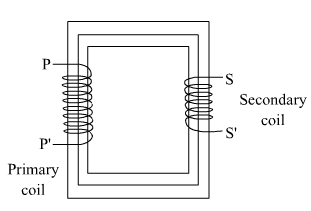(i) Write the function of a transformer. State its principle of working with the help of a diagram. Mention various energy losses in this device.
(ii) The primary coil of an ideal step-up transformer has 100 turns and the transformation ratio is also 100. The input voltage and power are 220 V and 1100 W, respectively. Calculate the:
a) number of turns in secondary
b) current in primary
c) voltage across secondary
d) current in secondary
e) power in secondary
i) A transformer is a device that changes a low alternating voltage into a high alternating voltage or vice versa.
Transformer works on the principle of mutual induction.
A changing alternate current in primary coil produces a changing magnetic field, which induces a changing alternating current in secondary coil. 
Energy losses in transformer:
Flux leakage due to poor structure of the core and air gaps in the core.
Loss of energy due to heat produced by the resistance of the windings.
Eddy currents due to alternating magnetic flux in the iron core, which leads to loss due to heating.
Hysteresis, frequent and periodic magnetisation and demagnetization of the core, leading to loss of energy due to heat.
ii)
a) Number of turns in secondary coil is given by, 
b) Current in primary is given by, ![]()
![]()


